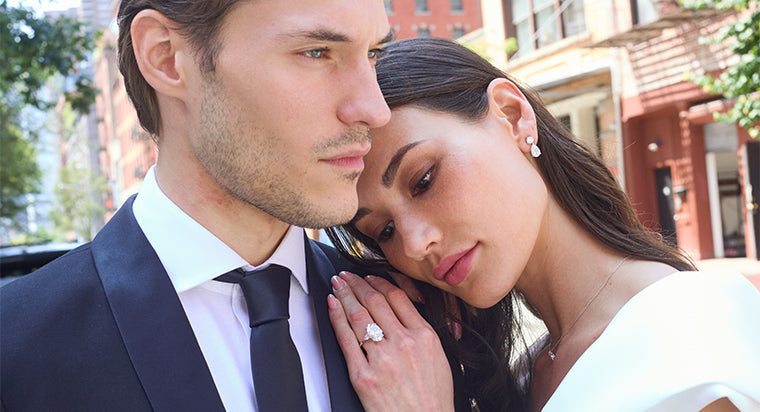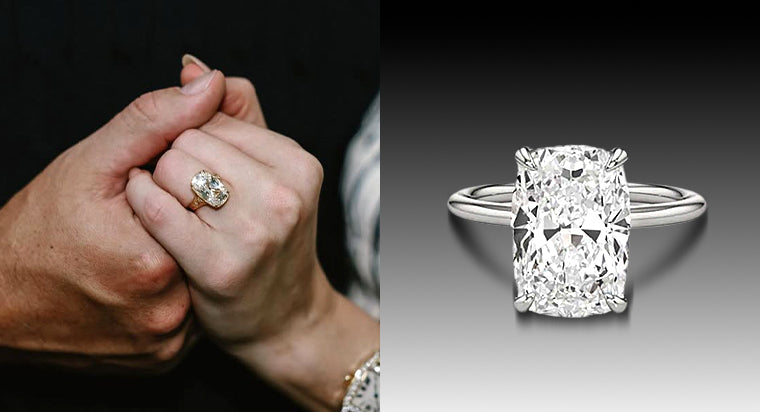9 Tips for Choosing the Right Lab-Grown Diamond Engagement Ring

More and more couples are turning to lab diamonds instead of traditional mined diamonds for their jewelry creations. Lab-grown diamonds are created in a controlled laboratory setting rather than formed deep within the Earth's crust, like natural diamonds. Nevertheless, these stunning gems are chemically identical to natural diamonds. That means they use the same materials and processes as natural diamonds to end up with a stone that is almost impossible to distinguish from a mined diamond in appearance. The best part is that these characteristics come at a much lower price. It's one of the many reasons lab-grown diamond engagement rings are becoming more popular.
But before you pick the perfect ring, you should know a few things about choosing the ideal lab-grown diamond. In this article, we will explore the world of lab-grown diamonds and provide nine essential tips for those considering them in lab diamond engagement rings.
Table Of Content
Our Top Tips for Choosing Lab-Grown Diamonds
1. Budget: Just as with natural diamond shopping, budget is critical. You will want to determine your budget beforehand, not after you've arrived at the store. It's important to note that lab-grown diamonds are often more cost-effective than natural diamonds. However, a lab diamond engagement ring can still be one of the bigger purchases a person makes in their lifetime, making it important to know how much you want to spend before you start shopping.
2. Diamond Quality (The Four Cs): You'll notice many similarities between picking a natural stone and a lab diamond, such as understanding the Four Cs - Carat weight, Cut, Color, and Clarity. These factors greatly influence the diamond's appearance and value. They are just as applicable to man-made diamonds as they are to earth-mined ones. Lab diamonds can indeed have less variability in these areas, with fewer inclusions and better color, but the 4Cs still hold true. Not every lab diamond is a perfect, colorless, and flawless specimen!
3. Certification: Lab diamonds do come with certification; this is how you can be sure of their grading in each of the 4 C categories. Always insist on a reliable diamond grading certificate, such as one from the Gemological Institute of America (GIA), to ensure transparency and authenticity. Reputable jewelers should always provide you with this documentation.
4. Diamond Shape: Did you know that lab diamonds can take a variety of shapes? It's wise to choose a diamond shape that suits your personal style and preferences. Minimalist brides or those who want a classic look may prefer a round-brilliant. Alternatively, vintage lovers might desire a more antique cut, such as an Asscher or marquise. The other most loved shapes are princess, emerald, pear, cushion, and oval.
5. Metal Choice: A diamond is only part of your engagement ring. When shopping for this very important accessory, consider the type of metal used for the ring setting and band. Common choices include white gold, yellow gold, platinum, or even eco-friendly options like recycled metals. Each metal has a slightly different appearance that can alter the ring's aesthetic. Rose and yellow gold have a vintage feel, while cool metals like platinum are considered more modern. Additionally, the characteristics of the metal can play into how easy the ring is to shape (if you want an intricate design), durability, and ability to be resized.
6. Ring Design: Speaking of shaping your ring, you can custom design lab diamond engagement rings to reflect your unique taste. Lab-grown diamonds can be set in various styles, from vintage to modern, and don't limit you to just one design. Take your time choosing the ideal setting and band style for your ring, taking into account personal style, lifestyle, and budget.
7. Ethical and Environmental Considerations: Lab-grown diamonds are often considered a more ethical and environmentally friendly choice, as they do not involve mining and have a smaller carbon footprint. You can also keep the rest of your ring eco-friendly by making eco-conscious choices, such as melting down another piece of jewelry for your ring setting and band or opting for other recycled materials.
8. Warranty and Return Policy: Using a reputable jeweler when purchasing a lab diamond engagement ring is important. Even if it costs less, you're still making a significant purchase. Therefore, ensure that the seller provides a comprehensive warranty and a clear return policy, allowing you peace of mind in case of any issues. You may also want to check whether or not they offer resizing and regular maintenance.
9. Reputable Seller: Purchase from a reputable and established seller or jeweler with a track record of providing high-quality lab-grown diamonds and excellent customer service. Lab diamonds are new to the industry but due to gaining popularity; there are more sellers. Do your research and choose one who has been offering lab diamonds for a while and knows the ins and outs.
Let Us Make Your Lab Diamond Shopping Easy
Lab-grown diamonds offer a compelling alternative to natural diamonds, combining affordability, ethical considerations, and customization options. You can make a well-informed choice by considering your budget, the Four Cs, certification, diamond shape, metal choice, ring design, ethical factors, warranty, and the seller's reputation. With Clarity has long seen the beauty of lab diamonds and offered them as a more environmental and budget-friendly option. Whether planning an engagement or celebrating a special occasion, lab-grown diamonds provide a brilliant and responsible choice for your diamond jewelry needs.









